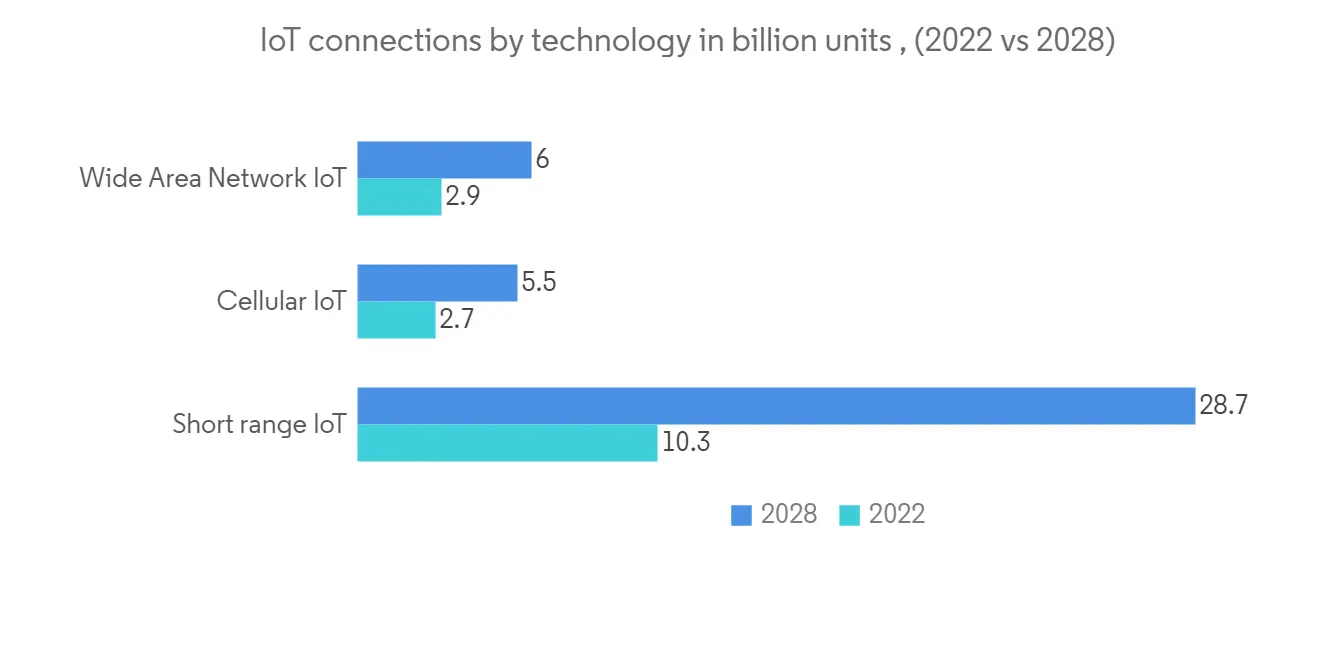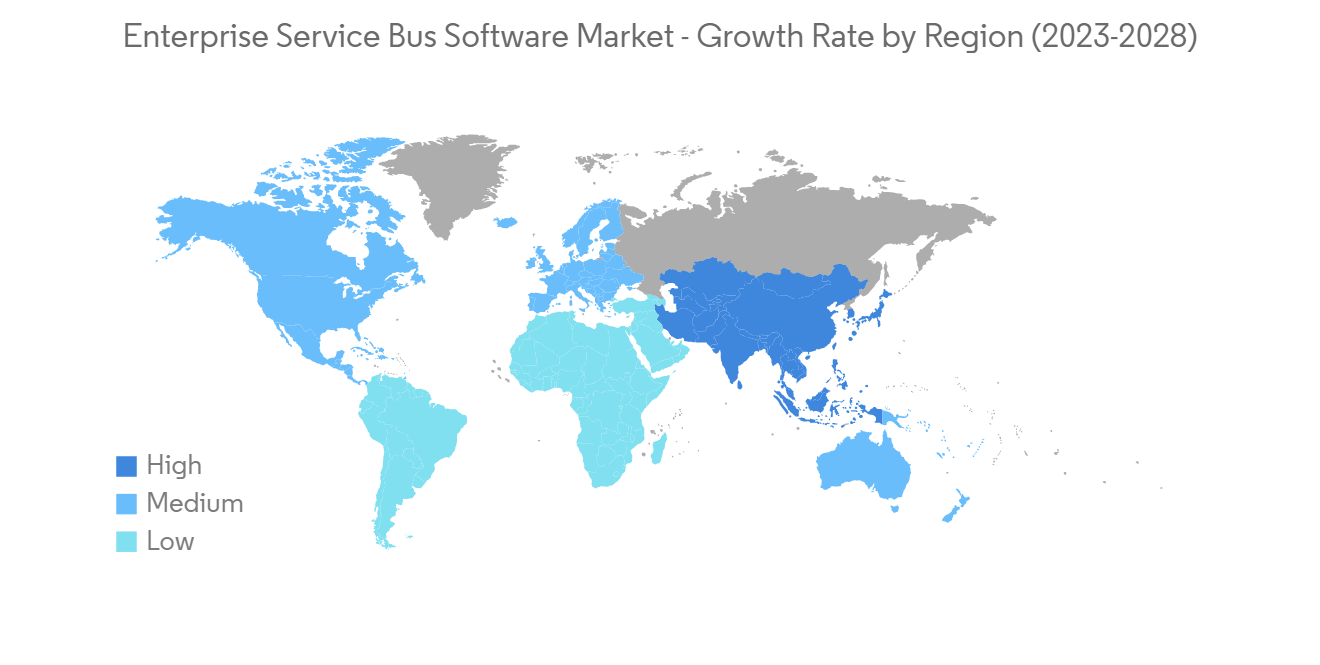 |
市場調査レポート
商品コード
1273323
エンタープライズサービスバス(ESB)ソフトウェア市場 - 成長、動向、予測(2023年-2028年)Enterprise Service Bus Software Market - Growth, Trends, and Forecasts (2023 - 2028) |
||||||
● お客様のご希望に応じて、既存データの加工や未掲載情報(例:国別セグメント)の追加などの対応が可能です。 詳細はお問い合わせください。
| エンタープライズサービスバス(ESB)ソフトウェア市場 - 成長、動向、予測(2023年-2028年) |
|
出版日: 2023年04月14日
発行: Mordor Intelligence
ページ情報: 英文 120 Pages
納期: 2~3営業日
|
- 全表示
- 概要
- 目次
エンタープライズサービスバス(ESB)ソフトウェア市場は、予測期間中に7.05%のCAGRで推移すると予測されています。
組織全体のアプリケーション統合の需要が高まっているため、エンタープライズサービスバス(ESB)は企業や組織全体で利用が増加しています。
主なハイライト
- COVID-19の発生により、ビジネスインテリジェンス、アナリティクス、クラウドコンピューティング、モバイルコンピューティングが、組織の円滑な運営に役立つことが証明されました。その後、企業はこれらのサービスを利用して、仕事のアーキテクチャを改善するようになりました。これが、市場におけるエンタープライズサービスバス(ESB)ソフトウェアのターニングポイントとなりました。
- ESBアーキテクチャは、アプリケーションを書き換える必要がないため、一部のネットワークやシステムが時折オフラインになる場合でも、企業間で情報を迅速に配布し、スムーズな情報伝達を保証します。このため、ほとんどの企業がITインフラのバックボーンとしてESBアーキテクチャを導入しています。
- さらに、さまざまなアプリケーションを統合する方法として機能するクラウドプラットフォームの採用が主な要因となっており、新たなチャネルの拡大や顧客データへのアクセスの向上により、よりニーズに合った製品やサービスの提供が可能になるため、ITおよび通信業界ではESBの使用率が大幅に上昇すると予想されます。
- 例えば、インドステイト銀行は、23,000の支店を擁し、従業員間のコミュニケーションとコラボレーションを改善し、モダンなワークプレイスに変えるために、マイクロソフトのクラウド型生産性ソリューションであるOffice 365を選択しました。
- データを紙で管理している古い企業は、クラウドに移行するのに時間がかかり、時にはビジネスのやり方に影響を与える可能性があります。また、一度にすべてのデータを変更するのではなく、部分的に変更する必要があります。また、導入コストが高いという懸念も、市場の成長に対する脅威となっています。
エンタープライズサービスバス(ESB)ソフトウェアの市場動向
IoTプロジェクトの開拓の高まりが市場成長を促進する
IoT接続デバイスの数は、2019年の86億台から2030年には294億台に増加すると予想されています。コネクテッドデバイスの成長は、新しいアプリケーションやビジネスモデルによってもたらされ、デバイスが標準化され、価格が下がっていることも後押ししています。
IoTに接続されたデバイスの数が増えるにつれ、デバイスとデータの統合はより複雑になっています。これらの接続されたデバイスは、統合とメッセージングに多くの課題をもたらす可能性があります。そのため、組織は、ESBで取り組むことができる効率的なアプリケーション統合ソリューションに投資しなければならないかもしれません。
この問題に対処する最も簡単な方法は、さまざまなデバイス(それぞれ異なるプロトコルを持つ)を単一のアプリケーションプラットフォーム上で同期させるという戦略に集中することです。
今後数年間、ESBソフトウェアの需要は、ビジネス環境の変化に伴い、異なるデバイス間の通信をより効果的かつ柔軟に処理する必要性に駆られると思われます。

アジア太平洋地域が予測期間中に著しい成長を遂げる
アジア太平洋地域は、中国、インド、韓国などの国々でIoTプラットフォームへの重点が拡大しているため、エンタープライズサービスバス(ESB)ソフトウェア市場の成長率が最も早いと予測されています。
また、この地域では、複雑なビッグデータや企業資源計画(ERP)などのワークロードがクラウドプラットフォームへの移行が進んでいるため、管理されたクラウドベースのソリューションに対する需要が高まっています。アジアクラウドコンピューティング協会(ACCA)が発表した報告書によると、シンガポールは、ブロードバンドの品質、サイバーセキュリティ、規制、ビジネスの洗練度が高いことから、アジア太平洋地域のクラウド対応国第1位となりました。
アジア太平洋地域のほとんどの企業が業務をクラウドに移行する中、アリババやテンセントなどの企業は、新しいプロジェクトが市場に出るまでの時間を短縮し、組織をより柔軟にするためにESBを使用すると考えられます。
また、より柔軟性の高いアプリケーションを構築・設計することで、企業は市場の変化に迅速に対応できるようになります。同地域のESBソフトウェア市場も、これらの要因から成長すると思われます。

エンタープライズサービスバス(ESB)ソフトウェアの業界概要
ベンダーの急増により、エンタープライズサービスバス(ESB)ソフトウェア業界は細分化されています。ESBソフトウェア市場を牽引しているのは、急速な開発、イノベーション、そして激しいプレイヤー競争です。その他、主要企業としては、Oracle Corporation、Microsoft Corporation、IBM Corporation、SAP SE、MuleSoft Inc.(Salesforce)、Dell Technologies Inc.、TIBCO Software Inc.などがあります。
2022年12月、レッドハットとゼネラルモーターズは、自動車業界のプレーヤーが最先端のソフトウェア技術を自社製品に統合するのを支援するために提携しました。両事業者は、レッドハットのクラウドネイティブテクノロジーのおかげで、付加価値の高い機能を顧客に迅速に提供することができます。車載ソフトウェアには高いレベルのサイバーセキュリティ保護が必要なため、このソフトウェアは、高度な運転支援システム、ボディコントロール、接続など、いくつかの車載安全アプリケーションをサポートすることになります。Linuxとクラウドネイティブテクノロジーは、オープンソースによるイノベーションのプロセスを加速させます。
その他の特典:
- エクセル形式の市場予測(ME)シート
- 3ヶ月間のアナリストサポート
目次
第1章 イントロダクション
- 調査の成果
- 本調査の前提条件
- 本調査の対象範囲
第2章 調査手法
第3章 エグゼクティブサマリー
第4章 市場力学
- 市場概要
- 市場促進要因
- クラウドベースのソリューションの採用が増加
- IoTプロジェクトの増加
- 市場抑制要因
- 高い導入コストが市場成長の妨げになる
- 業界の魅力- ポーターのファイブフォース分析
- 供給企業の交渉力
- 買い手/消費者の交渉力
- 新規参入業者の脅威
- 代替品の脅威
- 競争企業間の敵対関係
第5章 市場セグメンテーション
- 展開
- オンクラウド
- オンプレミス
- エンドユーザー産業
- IT・通信
- 小売業
- ヘルスケア
- BFSI
- その他エンドユーザー産業(政府、製造、公益事業)
- 地域
- 北米
- 欧州
- アジア太平洋
- ラテンアメリカ
- 中東・アフリカ
第6章 競合情勢
- 企業プロファイル
- Oracle Corporation
- Microsoft Corporation
- IBM Corporation(Red Hat Inc.)
- TIBCO Software Inc.
- SAP SE
- Salesforce.com Inc.(MuleSoft Inc.)
- Dell Technologies Inc.
第7章 投資分析
第8章 市場機会と将来動向
The Enterprise Service Bus Software Market is poised to register a CAGR of 7.05% during the forecast period. Due to the increasing demand for application integration across organizations, enterprise service buses (ESBs) witnessed a rise in their utilization across enterprises and organizations.
Key Highlights
- The COVID-19 outbreak demonstrated the value of business intelligence, analytics, cloud computing, and mobile computing for ensuring that organizations run smoothly. After this, companies started using these services to improve their work architecture. This was the turning point for enterprise service bus software in the market.
- ESB architecture distributes information across enterprises quickly and ensures the smooth delivery of information, even when some networks or systems are offline occasionally, by eliminating the need to rewrite the application. Thus, most companies implement the ESB architecture as the backbone of their IT infrastructure.
- Furthermore, majorly driven by the adoption of cloud platforms that serve as a way to integrate various applications and can facilitate new and expanded channels as well as improve access to client data, allowing for better-tailored products and services, the IT and telecom industries are expected to mark a significant rise in the use of ESBs.
- Banks are also moving more of their data, processes, and infrastructure to the cloud to take advantage of cloud implementation, which makes it easier for enterprise applications to work together.For instance, the State Bank of India, for its 23,000 branches, chose Office 365, a cloud-powered productivity solution from Microsoft, to improve communication and collaboration among its workforce and transform it into a modern workplace.
- Older businesses that keep their data on paper will take some time to move to the cloud, which could sometimes affect how the business works. They will also have to change parts of the data at a time instead of all of it at once. Concerns about the high cost of installation are also a threat to the growth of the market.
Enterprise Service Bus Software Market Trends
Rising Development of IoT Projects Boosting the Market Growth
The number of IoT-connected devices is expected to increase from 8.6 billion in 2019 to 29.4 billion in 2030. The growth of connected devices is driven by new applications and business models, and it is helped by the fact that devices are becoming more standard and their prices are going down.
As the number of IoT-connected devices increases, the integration of devices and data becomes more complex. These connected devices may present numerous integration and messaging challenges. Organizations, thus, may have to invest in efficient application integration solutions that can be tackled with ESBs.
Also, as there are more and more devices that connect to each other, it is becoming more and more important to manage multiple networks and systems at the same time.The easiest way to deal with this problem is to concentrate on a strategy that involves synchronizing various devices (each with a distinct protocol) on a single application platform.
Over the next few years, demand for ESB software is likely to be driven by the need to handle communication between different devices in a more effective and flexible way as business environments change.

Asia-Pacific to Register a Significant Growth Over the Forecast Period
Asia-Pacific is predicted to have the quickest growth rate for the Enterprise Service Bus Software Market due to the region's expanding emphasis on the IoT platform in nations like China, India, and South Korea.
The rising demand for managed cloud-based solutions has also increased in this region due to complex big data and workloads, such as enterprise resource planning (ERP), being increasingly migrated to cloud platforms. According to a report published by the Asia Cloud Computing Association (ACCA), Singapore is the number one cloud-ready Asia-Pacific country, owing to better broadband quality, cybersecurity, regulation, and business sophistication.
As most businesses in Asia-Pacific move their operations to the cloud, companies like Alibaba and Tencent are likely to use ESBs to make their organizations more flexible by reducing the time it takes for new projects to reach the market.
It also builds and designs applications that are more flexible, which lets companies respond quickly to changes in the market. The ESB software market in the region is also likely to grow because of these factors.

Enterprise Service Bus Software Industry Overview
Due to the proliferation of vendors, the enterprise service bus software industry is fragmented. Rapid development, innovation, and intense player competition are what are driving the ESB software market. In addition to others, some of the major companies are Oracle Corporation, Microsoft Corporation, IBM Corporation, SAP SE, MuleSoft Inc. (Salesforce), Dell Technologies Inc., and TIBCO Software Inc.
In December 2022, Red Hat and General Motors joined to assist the car industry player in integrating cutting-edge software technology into its offerings. Both businesses can quickly provide clients with additional valuable features because of Red Hat's cloud-native technology. This software will support several in-vehicle safety applications, like sophisticated driver assistance systems, body control, and connection, since high levels of cybersecurity protection are necessary for in-vehicle software. Linux and cloud-native technology will speed up innovation processes through open source.
Additional Benefits:
- The market estimate (ME) sheet in Excel format
- 3 months of analyst support
TABLE OF CONTENTS
1 INTRODUCTION
- 1.1 Study Deliverables
- 1.2 Study Assumptions
- 1.3 Scope of the Study
2 RESEARCH METHODOLOGY
3 EXECUTIVE SUMMARY
4 MARKET DYNAMICS
- 4.1 Market Overview
- 4.2 Market Drivers
- 4.2.1 Growing Adoption of Cloud-based Solutions
- 4.2.2 Rising Development of IoT Projects
- 4.3 Market Restraints
- 4.3.1 High Installation Cost to Challenge the Market Growth
- 4.4 Industry Attractiveness - Porter's Five Forces Analysis
- 4.4.1 Bargaining Power of Suppliers
- 4.4.2 Bargaining Power of Buyers/Consumers
- 4.4.3 Threat of New Entrants
- 4.4.4 Threat of Substitute Products
- 4.4.5 Intensity of Competitive Rivalry
5 MARKET SEGMENTATION
- 5.1 Deployment
- 5.1.1 On Cloud
- 5.1.2 On-premise
- 5.2 End-user Industry
- 5.2.1 IT and Telecom
- 5.2.2 Retail
- 5.2.3 Healthcare
- 5.2.4 BFSI
- 5.2.5 Other End-user Industries (Government, Manufacturing, and Utilities)
- 5.3 Geography
- 5.3.1 North America
- 5.3.2 Europe
- 5.3.3 Asia-Pacific
- 5.3.4 Latin America
- 5.3.5 Middle East & Africa
6 COMPETITIVE LANDSCAPE
- 6.1 Company Profiles
- 6.1.1 Oracle Corporation
- 6.1.2 Microsoft Corporation
- 6.1.3 IBM Corporation (Red Hat Inc.)
- 6.1.4 TIBCO Software Inc.
- 6.1.5 SAP SE
- 6.1.6 Salesforce.com Inc. (MuleSoft Inc.)
- 6.1.7 Dell Technologies Inc.
